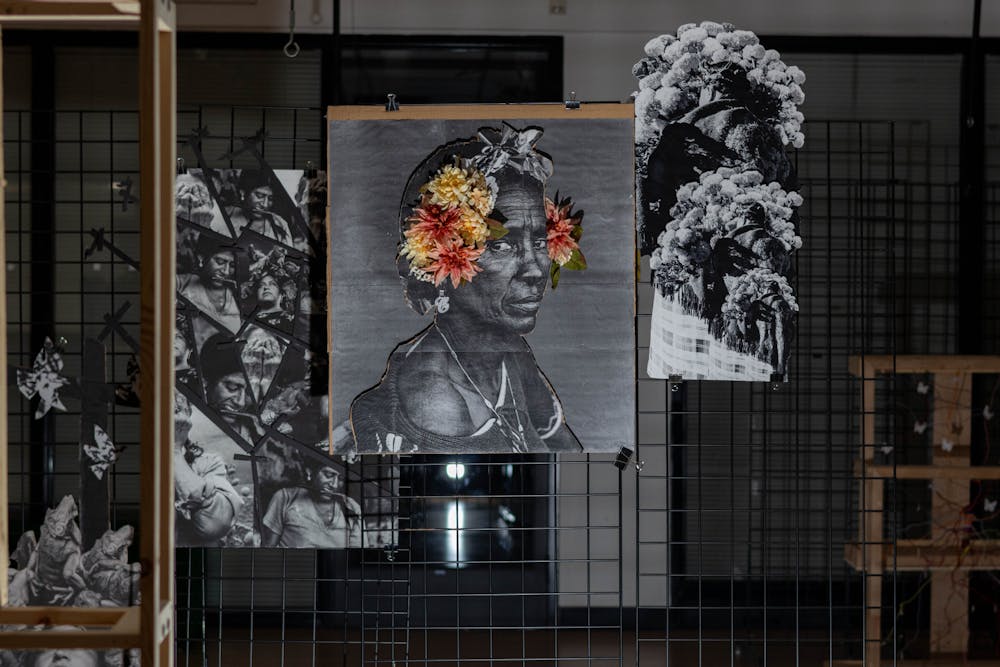In the main room of the Design South Building, photographs of Latin American architecture spiral into three-dimensional collages. The display is part of an annual student showcase curated by Jose Bernardi, an associate professor at the Design School who has taught Latin American Design, and runs through Feb. 10.
Bernardi brought a meditative insight to the Design School this semester, focusing on teaching the graduating class of interior design majors that there is no wrong answer and every inquiry is worth exploring. By welcoming creative liberty into the classroom, Bernardi gave students a break from drafting their usual floor plans.
Leah Henthorne, a senior studying interior design, said this creative license is an opportunity to manipulate images in more elaborate ways, such as curating hypnotic Penrose stairs in her piece.
"I'm kind of using the staircases as a way to tell the story through the architecture," Henthorne said.
The images used for the exhibit's collages were sourced from notable Latin American photographers and designers, including Sandra Eleta, who is known for capturing themes of servitude and grief in everyday South American life.
"I wanted to blend (the images) into one another in a way that felt like storytelling," Brenda Tena Gomez, a senior studying interior design, said.
In one collage, Gomez fashioned photographs into spirals. In the photographs, a woman studies the camera in deep thought, with a young girl spiraling through the background. The girl stares sternly into the camera with a flat expression, with palm fronds falling over her shoulders like angel wings.
"I had them apply the design principles to the work under consideration," Bernardi said. He chose the architects and photographers featured in the collages.
Students researched the work of the artists to help guide their collages. They were asked to interpret the themes of servitude, community and even hidden persons in a series where the focus was asked to conceal their face.
"I think it's what we took from those images. It was just about being creative with it and what we saw," Hannah Zavala, a senior studying interior design, said.
Bernardi's curriculum combines cultural awareness seamlessly with design principles.
"We're only design students who do design, so we don't really get to explore other areas of other people's majors and stuff," said Gomez. "But for me, as someone who's Hispanic, I don't really see this very often so when I do it's kind of like, 'I wish I could learn more about it.'"
Gomez referred to Bernardi's curriculum as a respite from traditional western views of design, offering unique opportunities at exploring different cultures through architecture and photography. Hethorne agreed.
"I appreciated that this was a required class for our major," senior and interior design major Caden Van Dine said. "(Bernardi) sets up this exhibit every semester, and I've seen it and I never thought that it was something that we had to do. So it was cool to be like, 'Oh, I get to do that—take a break from floorplans and all that stuff."
This passion in the classroom instills a sense of wonder in everyone it comes into contact with.
"Lots of professors just say, 'Here's your project, figure it out,'" Abigail Kariolich, a senior studying interior design, said. "He actually wants us to learn. He wants us to be passionate. He wants us to understand how much he's passionate about his work, which is kind of cool."
The senior class of the Herberger Design School brought familiar culture to the classroom, utilizing design elements to create artwork outside of the traditional box of interior design.
"If (other students) saw this they wouldn't think it came from interior design," Gomez said. "It would have come from an artist or just (be) art."
Edited by Sophia Braccio, Sadie Buggle and Grace Copperthite.
Reach the reporter at aboulang@asu.edu.
Like The State Press on Facebook and follow @statepress on X.




